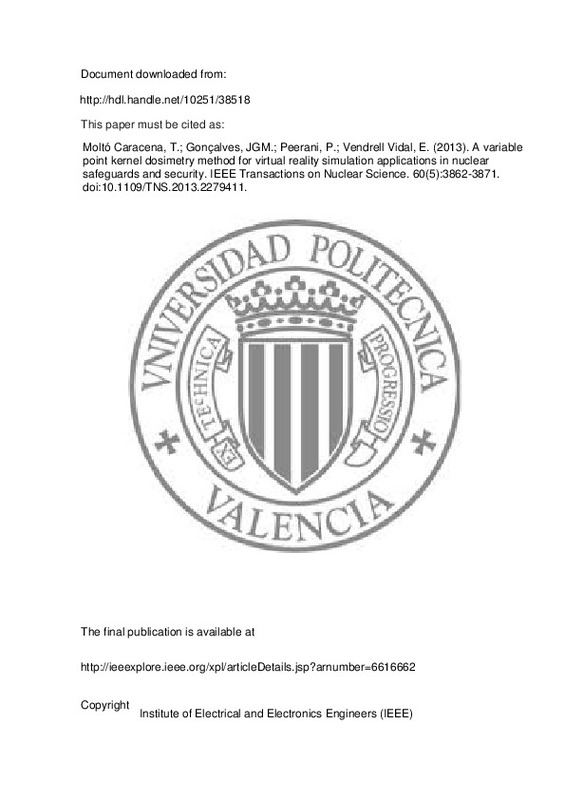JavaScript is disabled for your browser. Some features of this site may not work without it.
Buscar en RiuNet
Listar
Mi cuenta
Estadísticas
Ayuda RiuNet
Admin. UPV
A variable point kernel dosimetry method for virtual reality simulation applications in nuclear safeguards and security
Mostrar el registro sencillo del ítem
Ficheros en el ítem
| dc.contributor.author | Moltó Caracena, Teófilo
|
es_ES |
| dc.contributor.author | Gonçalves, João G. M.
|
es_ES |
| dc.contributor.author | Peerani, Paolo
|
es_ES |
| dc.contributor.author | Vendrell Vidal, Eduardo
|
es_ES |
| dc.date.accessioned | 2014-07-02T09:45:05Z | |
| dc.date.issued | 2013-10 | |
| dc.identifier.issn | 0018-9499 | |
| dc.identifier.uri | http://hdl.handle.net/10251/38518 | |
| dc.description | © 2013 IEEE. Personal use of this material is permitted. Permission from IEEE must be obtained for all other uses, in any current or future media, including reprinting/republishing this material for advertising or promotional purposes, creating new collective works, for resale or redistribution to servers or lists, or reuse of any copyrighted component of this work in other works. | es_ES |
| dc.description.abstract | This paper presents an algorithm to calculate gamma dose rates intended for virtual reality (VR) applications. It dynamically adapts the method to cope with both accuracy and time requirements. Given the real-time constraints imposed by VR applications, more accurate, but computationally intensive stochastic algorithms (e.g., Monte Carlo) are not suited to this task. On the opposite end, a Point Kernel (PK) method can be effective in some cases with as little as one point (mono PK) to define a source, in contrast with the millions of points that Monte Carlo computes. Simple mono PK codes may lack the desired accuracy in some circumstances, requiring a more detailed source representation. In this work, a novel method is presented which automatically estimates the appropriate level of detail for a source's volumetric representation, then generates a non-regular mesh model and subsequently computes the dose rate via a PK method, performing this three-step process in real time. | es_ES |
| dc.description.sponsorship | This work was supported by the European Commission's Joint Research Centre Ph.D. grant program. | en_EN |
| dc.format.extent | 10 | es_ES |
| dc.language | Inglés | es_ES |
| dc.publisher | Institute of Electrical and Electronics Engineers (IEEE) | es_ES |
| dc.relation.ispartof | IEEE Transactions on Nuclear Science | es_ES |
| dc.rights | Reserva de todos los derechos | es_ES |
| dc.subject | Computer simulation | es_ES |
| dc.subject | Point Kernel | es_ES |
| dc.subject | Gamma dosimetry | es_ES |
| dc.subject | Virtual reality (VR) | es_ES |
| dc.subject.classification | INGENIERIA DE SISTEMAS Y AUTOMATICA | es_ES |
| dc.title | A variable point kernel dosimetry method for virtual reality simulation applications in nuclear safeguards and security | es_ES |
| dc.type | Artículo | es_ES |
| dc.embargo.lift | 10000-01-01 | |
| dc.embargo.terms | forever | es_ES |
| dc.identifier.doi | 10.1109/TNS.2013.2279411 | |
| dc.rights.accessRights | Abierto | es_ES |
| dc.contributor.affiliation | Universitat Politècnica de València. Departamento de Ingeniería de Sistemas y Automática - Departament d'Enginyeria de Sistemes i Automàtica | es_ES |
| dc.description.bibliographicCitation | Moltó Caracena, T.; Gonçalves, JGM.; Peerani, P.; Vendrell Vidal, E. (2013). A variable point kernel dosimetry method for virtual reality simulation applications in nuclear safeguards and security. IEEE Transactions on Nuclear Science. 60(5):3862-3871. doi:10.1109/TNS.2013.2279411 | es_ES |
| dc.description.accrualMethod | S | es_ES |
| dc.relation.publisherversion | http://ieeexplore.ieee.org/xpl/articleDetails.jsp?arnumber=6616662 | es_ES |
| dc.description.upvformatpinicio | 3862 | es_ES |
| dc.description.upvformatpfin | 3871 | es_ES |
| dc.type.version | info:eu-repo/semantics/publishedVersion | es_ES |
| dc.description.volume | 60 | es_ES |
| dc.description.issue | 5 | es_ES |
| dc.relation.senia | 257234 | |
| dc.contributor.funder | European Commission | es_ES |







![[Cerrado]](/themes/UPV/images/candado.png)

